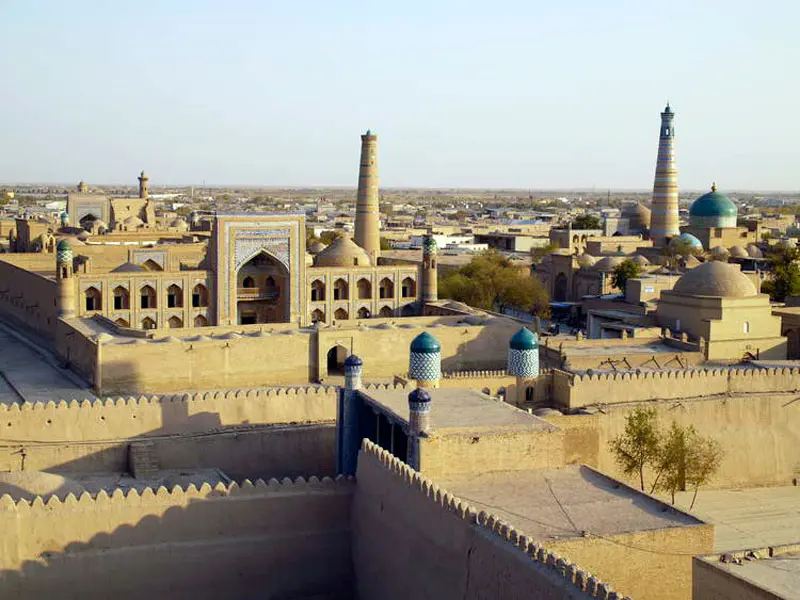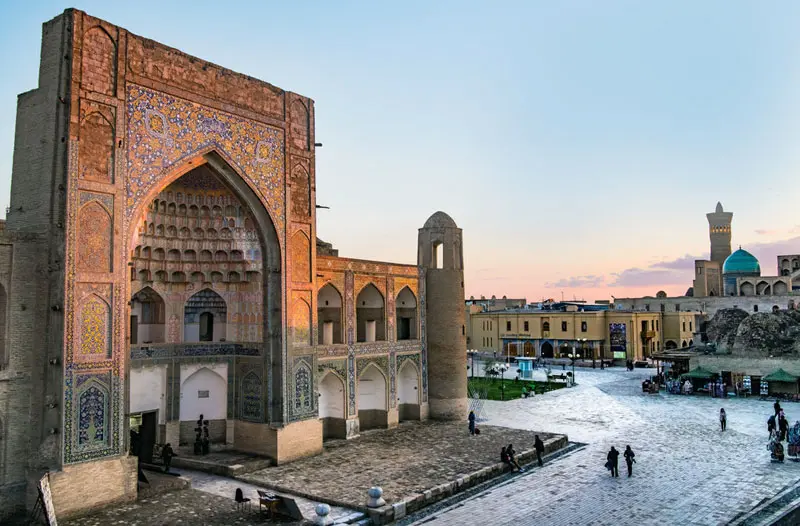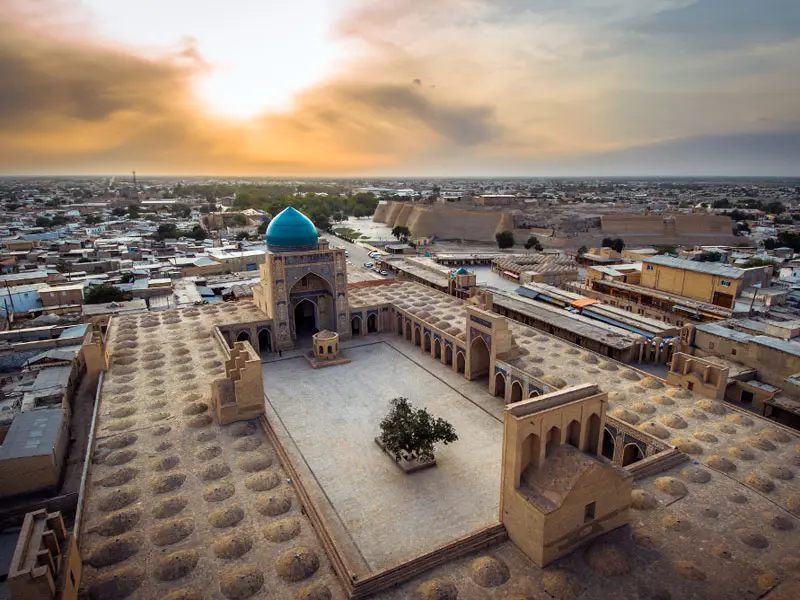Uzbekistan is an incredibly rich country, first and foremost generously endowed with centuries-old traditions and architectural masterpieces that testify to a rich past. In order to preserve and popularize its historical-cultural monuments, Uzbekistan in 1993 joined the UN International Organization for Education, Science and Culture (UNESCO). Now four architectural complexes and five objects of intangible cultural heritage are represented in the UNESCO list of Uzbekistan, with more than 30 objects being at the stage of inclusion. The preserved cultural and natural monuments, which we’ll describe below, are of great value for the Uzbek people and all of humanity in a whole.
UNESCO Sites in Uzbekistan: Itchan-Kala

Itchan Kala is the historical inner city of Khiva. Officially, the status of the “protected city” Old Khiva received in 1968. The fortress, palaces, mosques, madrasas, mausoleums and minarets, caravanserais and baths turned Itchan-Kala into a unique monument. The fortress town occupies an area of 26 hectares and is completely surrounded by a fortified wall of 2,200 m. There are 4 gates that overlook to all four sides of the world: Ata-darvaza, Tash-darvaza, Bakhcha-darvaza, Palvan-darvaza. The first thing that impresses with its majesty in Khiva is the huge walls of Itchan-Kala, which have been well preserved to this day as a rare example of medieval fortifications. The fortress walls are made of mud blocks, and their height reaches up to 10 meters. The whole fortress gives an impression of inaccessibility and intimidating power.
Ichan Kala with full confidence can be called an open-air museum. However, even in the 21st century, approximately 2,000 inhabitants still live in the town name in the northern and southern parts. The history of the city goes back centuries. The exact age of the city is difficult to determine even for scientists - it was built over the centuries, and according to some studies, Itchan Kalan has an approximate age of 2500 years. In 1511, when Khiva was chosen as the capital, the Khiva Khans settled here and built a residence as well as madrasas and minarets. With the growth of population, a second city appeared - Dishan Kala, also surrounded by a fortress wall. Thus, the city initially had 2 protective rings, however, only the inner part of the wall of Itchan Kala preserved till our days.
UNESCO Sites in Uzbekistan: Historic Center of Shakhrisyabz
Shahrisabz is one of the oldest cities in Uzbekistan, which is about 2,700 years old. It is glorified as the hometown of the great commander Amir Temur, historically known as Tamerlane. The heyday of the city falls under the rule of Tamerlane and his successors (XIV-XV centuries). Due to its location on the Great Silk Road, Shakhrisabz was the cultural and political centre of the Kesh region. One of the unique architectural monuments of the city, testifying to the past glory of its founder, are the ruins of the palace of Tamerlane - Aksaray, the memorial complex DorutTilavat and the mosque KokGumbaz. Among other things, in the historic centre of Shakhrisabz are also concentrated ancient quarters, bearing evidence of the centuries-old history of this city. The historical centre of Shakhrisabz was included in the UNESCO list of tangible cultural heritage in 2000.
UNESCO Sites in Uzbekistan: Historic Center of Bukhara

Bukhara is one of the oldest cities located on the Great Silk Road, which is approximately 2 thousand years old. The layout of the city has not changed much since the Middle Ages - today Bukhara is the most complete example of the medieval city of Central Asia. Bukhara is truly a holy city not only for the Uzbek people but also for the entire Islamic world.
The whole centre of Bukhara is one big historical monument, which is inscribed on the UNESCO World Heritage List. This is a huge historical and architectural complex consisting of about 150 sights: mosques, madrasas (religious schools), minarets and markets, caravanserais, as well as old one-storey houses made of sun-dried bricks. One of the brightest and unique attractions of this city are the covered street intersections which have become kind of market. The oldest monument in Bukhara is the Ark citadel, the construction of which dates back to the early feudal period of the 5th – 7th centuries. Another precious monument that reached us from the era of Samanids (IX-X centuries), is the mausoleum of Ismail Samani - one of the classic works of Central Asian architecture. High artistic effect of the facades of the mausoleum has been achieved through the use of backed brick and combined masonry technology. All in all, Bukhara is considered the hallmark of Uzbekistan with vibrant streets full of tourists, souvenir shops, cafes and chaykhanas with an Asian flavour.
UNESCO Sites in Uzbekistan: Samarkand

Samarkand was founded in the 7th century BC and since then was considered to be the pearl of Central Asia. Like Bukhara, Samarkand was one of the most important cities in the region thanks to being situated on the Grand Silk Way. Samarkand was most developed and flourished during the reign of Amir Temur and the Timurids dynasty. The main attractions of Samarkand are the Registan Square, the Bibi-Khanum Mosque, the Shah-i-Zinda Mausoleum and the Gur-Emir complex. The historic centre of Samarkand was included in the UNESCO world heritage list in 2001.
Along with fantastic architectural and magnificent historical sights, there are numerous places to see and to experience including noisy souvenir workshops of artisans and craftsmen who produce fine fabrics or different national-flavored souvenirs.
UNESCO Sites in Uzbekistan: Western Tien-Shan Mountains
The Western Tien Shan Mountain range, located at the junction of three neighbouring countries - Uzbekistan, Kazakhstan and Kyrgyzstan, was included in the UNESCO World Heritage List in 2016. The World Heritage Committee unanimously acknowledged the uniqueness of this region’s nature, which is characterized by a high level of endemism which means that some animals and plants inhabit only in this certain geographical area. Moreover, the mountain range was included in the UNESCO as a precious natural sight due to being a home for numerous endangered species of flora and fauna, among which the Menzbir marmot, the snow leopard, the Karatau mountain sheep, and many others can be distinguished. The Western Tien-Shan includes 11 sites that are part of seven natural protected territories of three countries.
Choose the Tour to Central Asia you like most and we will organize your amazing holidays in 5 stans.













